Mycenaean civilization
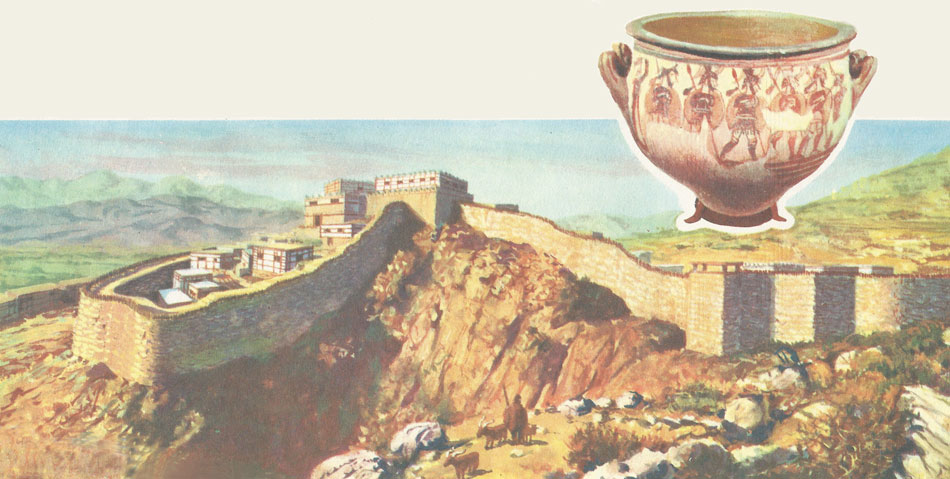
A reconstruction of the citadel at Mycenae. Inset (upper right): The 'Warrior Vase' depicting soldiers of the Trojan War.
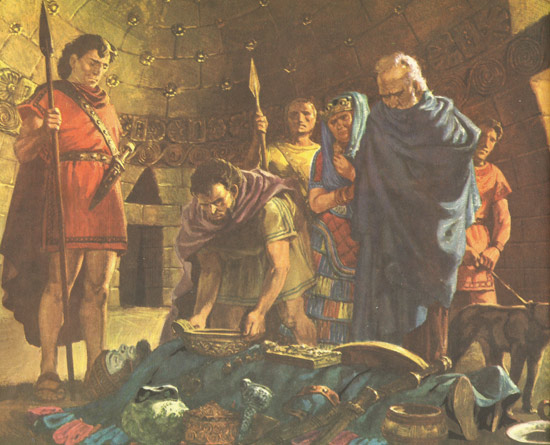
The funeral of a Mycenaean king in one of the 'beehive' tombs. These imposing structures, dug out of the hillside, were as high as the diameter of their base.
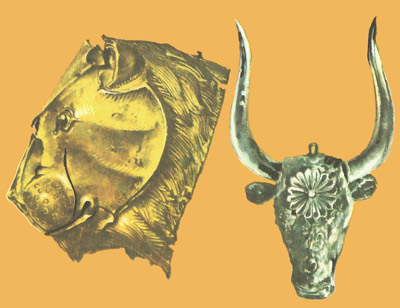
Some of the treasures Schliemann discovered in the shaft graves. The three vases were used for libations (drink offerings to the gods), and so were like funnels, with a hole in the bottom. They are of beautiful craftsmanship. One shows the siege and assault of a city; two are in the shape of animals' heads. The bull's head may have had a special religious significance here, as it did at Knossos. (Left) Precious gold libation vase, in the form of a lion's head. (Right) Silver 'rhyton' shaped like a bull's head.

Details of a bronze dagger-blade, beautifully inlaid in gold and silver with a scene of a lion hunt.
Troy, the great city of King Prian, withstood a 10-year siege in the Trojan War before being finally captured and destroyed by the Greeks. Many stories were told about this war, particularly in Homer's long epic poem the Iliad. According to tradition, the Greek warriors were led by several mighty heroes who were also kings of parts of Greece. But the supreme commander was Agamemnon, King of Mycenae, the city 'rich in gold'.
So much of the Iliad is clearly legend that by the 19th century most scholars doubted whether the Trojan War had ever taken place, or whether Troy had even existed. But in 1870 this was proved true. A rich German amateur, Heinrich Schliemann, found at Hissarlik in Turkey the remains of no fewer than nine cities of Troy, one on top of the other. We now know that one of these – though not the one Schliemann thought – was the Troy sacked by the Greeks.
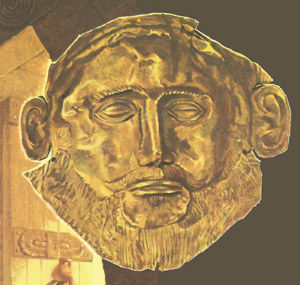 |
| Gold death-mask of a Mycenaean king – from a shaft grave
|
Mycenae 'rich in gold'
After his triumphs at Troy Schliemann decided to look for the city of Agamemnon. The site of Mycenae was well enough known, but not much had yet been discovered there. Schliemann, however, with his uncanny instinct for digging in the right place, found within the walls five shaft graves in a great Grave Circle. (A sixth was discovered later.) The bodies buried there were laden with gold: the men's faces were covered with masks of gold leaf, and by their sides lay finely wrought gold and silver swords, daggers, and drinking cups. Schliemann thought he had discovered the grave of Agamemnon; but in fact these graves are about 400 years older than Agamemnon, who was perhaps buried in one of the 'beehive' tombs. In a house near the Grave Circle Schliemann found the famous 'Warrior Vase', which shows warriors exactly as described in the Iliad.
Since Schliemann's discoveries other archaeologists have continued digging at Mycenae – notably Alan Wace, and Englishman, and John Papadimitriou, a Greek. In 1952 Dr Papadimitriou discovered outside the walls a second, even older Grave Circle, whose graves also contained wonderful gold and silver ornaments. Also outside the walls have been found several wealthy houses, where Professor Wace discovered clay tablets written in the script called 'Linear B'. This script has now been deciphered; the language is an early form of Greek.
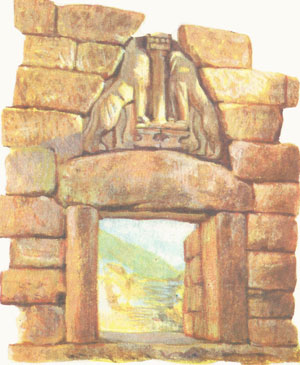 |
| The Lion Gate, ceremonial entrance to the citadel of Mycenae. It was built in 1350 BC.
|
The walls of the citadel, built in about 1350 BC, are constructed with such massive blocks of stone that legend said they were built by Cyclops (one-eyed giants). The main entrance is called the Lion Gate because of the magnificent stone lions that surmount it. Within the citadel little remains standing. The threshold of the Lion Gate is marked with ruts worn by ancient chariot-wheels. Immediately inside the Gate there is on the left a small chamber for the gatekeeper, and on the right a granary where large stone storage jars have been found. Beyond the granary is Schliemann's Grave Circle. The Cyclopean walls leave the natural line of defence to include it; this shows clearly that the graves were those of kings. Of the palace itself little remains except the Grand Staircase, and enough of the foundations to reveal the ground plan. As at Knossos, there is no temple – only a small shrine-room within the palace. Perhaps the most striking feature of the entire fortress is the secret water supply provided for the garrison in time of siege. A steep flight of steps leads down through the wall in the north-east corner of the citadel to a deep underground water-cistern, fed by earthenware pipes from a spring outside the walls.
 |
| Dagger from Mycenae
|
The 'beehive' tombs
Apart from the citadel itself, the most imposing remains at Mycenae are the enormous tholos tombs, each dug out of the sloping hillside in the shape of a beehive. Built with huge blocks of stone, studded on the inside with bronze ornaments (which must have gleamed like stars in the semi-darkness), they were covered on the outside with a mound of earth. Each was approached by an unroofed entrance passage called a dromos.
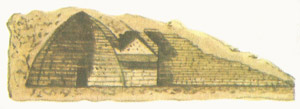 |
| Section of the 'Treasury of Atreus' (c. 1330 BC), finest of the tholos tombs at Mycenae. Note the unusual inner chamber.
|
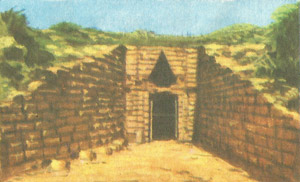 |
| The dromos (entrance passage).
|
Unlike the shaft graves, a tholos tomb contained the bodies of only one king and his immediate family. Funeral gifts were ceremonially burned before the tomb was sealed.
Other Mycenaean sites
We know from the 'Catalogue of Ships' in the Iliad and from the later Greek historian Thucydides that Mycenae was the most powerful state in Greece in the late Bronze Age. Of the other major Mycenaean cities, some cannot be excavated: at Thebes, for instance, the modern town is built over the ancient city, and at Athens the Erechtheum is on the site of the Mycenaean palace. But some imposing remains have been discovered, notably the immensely strong fortress of the hero Diomedes at Tiryns, and the beautifully situated palace of Nestor at Pylos, where many 'Linear B' tablets were found. One palace which has never yet been located, however, is that of Menelaus at Sparta.
The Dorian invasions
The brilliant Mycenaean civilisation did not long survive its greatest military triumph, the sack of Troy (c.1240 BC). Within a century it had collapsed before the invasions of the Dorians, who captured and burnt the fortresses. These rough highlanders were the last wave of Greek-speaking peoples to enter Greece. It is sometimes said they were victorious because they used iron weapons, which were stronger than bronze weapons of the Mycenaeans. This is unlikely – the Dorians came from the north, and iron entered Greece gradually from the eastern Mediterranean.
The earlier Greeks either remained as the Dorians' subjects or slaves, or fled across the seas. Each district became isolated from its neighbours. Writing and other civilised arts – except the oral epic poetry – disappeared completely. Upon Greece had descended the Dark Ages, out of which was later to grow the very different 'classical' civilisation of the city-state.
